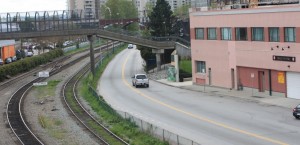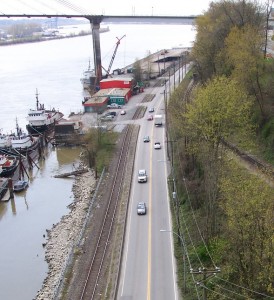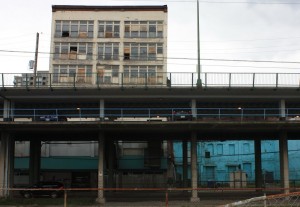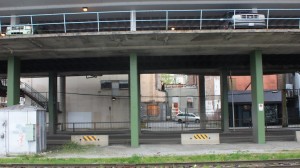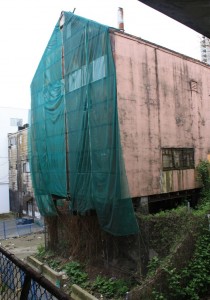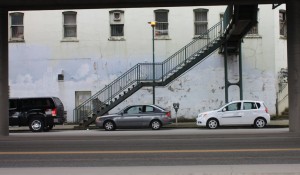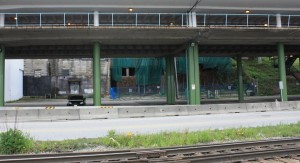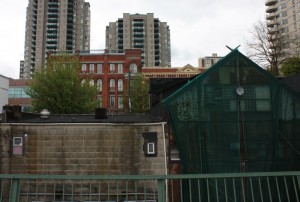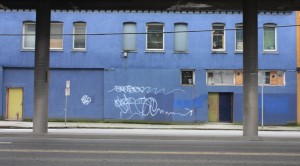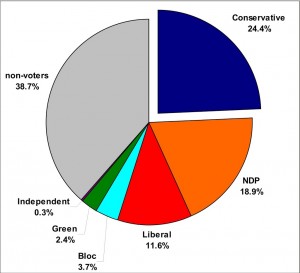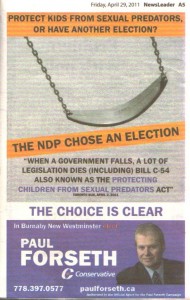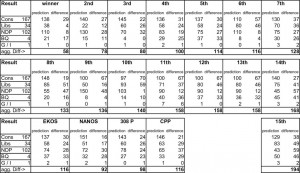I haven’t blogged on the topic of the fourth TransLink Workshop on the UBE yet, mostly because I waiting for TransLink to put the materials from the latest workshop on line (which they have just done!). so I will get on that next and discuss at length the latest coat of polish applied to that particular pair of old shoes.
In the meantime, I want to address the bigger issue, the one that seems to be the source of much of the push-back on the UBE: the idea that the UBE may worsen our traffic problems City-wide, not make them better. For the first time during these workshops, TransLink brought some materials to address this concern. As part of their pre-workshop presentation, Delcan presented a single PowerPoint slide that showed how they plan to address the NFPR in New Westminster. It was short on detail (there was not timing or budget mentioned) and there were no graphics except an image of the current proposed NFPR route with word-clouds pointing to several proposed improvements, paraphrased here:
1) Widening Front Street to 4 lanes;
2) Re-aligning the intersection at Columbia and Brunette so that Brunette is a continuous road and Columbia joins it at a “T”;
3) Doing a similar realignment at Front so that the Front Street-Columbia-east connection is a thoroughfare, and Columbia Street-west joins at a “T”;
4) Again making the Front Street-to-Stewardson a straight shot with Columbia meeting it at a “T” west of Hyack Square;
5) Tearing down the Parkade; and
6) Re-aligning several intersections on Stewardson, including Royal Ave.
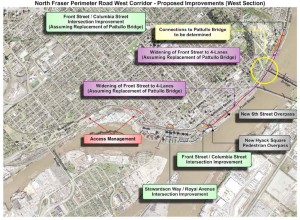 |
| Click to zoom in, TransLink’s Christmas Wish List. |
At this point, this list is akin to my thumbing through the toy section of the Sears Christmas Catalogue when I was 7 years old and checking off the toys I wanted (Lego: check! Matchbox cars; Check! Smash-up-Derby? Check! Hungry Hungry Hippos? Why not!; Millennium Falcon? Double Check!). There was about an equal amount of planning and budgeting for how I was going to get those Christmas presents as there is here.
Making Front Street four lanes is going to take significantly more than a sweep of the hand or drawing a grey dotted line on a map. As much as I agree that White Elephant Parking Inc. should go, it is hardly the only limiting factor here. As Matt Laird keeps asking: are you going to move the Keg building and the Sally Ann, or the rails? Where the rail grades separate to the east; which of the two is going to have to go? What of the rail and Skytrain underpasses? Currently there isn’t room for a sidewalk on Front, and you want to install two more driving lanes?
Then there are the intersections. East Columbia at Front has no room for a T-intersection, as the tight “Y” there now is sandwiched between rails and (I kid you not) a “Heritage Wall” whose ultimate immovability has been used by the City to argue against pedestrian- and cyclist-safety improvements at Columbia and McBride. At the other end, what will Hyack Square look like attached to a new T-intersection onto the truck route?
And I don’t know if anyone else noticed, but since the recent traffic calming around Stewardson between 3rd Ave and 5th Ave, the traffic back-up getting onto the Queensborough has noticeably expanded, as has the back-up on 6th Ave to get to the bridge, and the congestion coming off the bridge down the hill along Stewardson. With a less-fettered through-shot to Freeway offered by a doubling of Front Street, does anyone imagine that Stewardson is going to see less traffic? When (or more importantly, where) is this game of Whack-a-Mole going to stop?
Through this very few people are asking the City if they even want an inevitably-congested 4-lane limited access road cutting the City off from it’s waterfront forever. For too many people, it is taken as inevitable that this will happen, and we need to manage the “mitigation” as best we can.
Please people, take a trip to Downtown Seattle before you make that call. If you lack travel funds, but have some imagination, just go down to the Front Street Parkade and look at the ass end of the businesses on Columbia: wood that hasn’t seen paint in 50 years, bricks swollen with too many layers of peeling paint, tarps keeping the leaks out, broken or boarded up windows, rusty chain-link and barbed wire, graffiti, garbage, shopping carts, blackberries and ivy…
This is our City’s waterfront. Despite the efforts of the Antique Alley merchants, it is a dark and dismal place. In many areas, the general dilapidation is embarrassing, and will only become more so as the Pier Park draws people down to the river: this is what they will see when they look back. This will be the face of New Westminster to those visitors.
Now tug at the braids of your imagination a bit and think about what could be.
It could be full of vibrant businesses and comfortable homes, just as Columbia Street is. It could be opened up to let the sunlight in and the exhaust out. It could be made pedestrian friendly, it could be safe and attractive. The empty parking bays could be courtyard restaurants, or pocket green parks. The Antique Alley businesses could see walk-by customers again. The entire downtown could be improved with new high-value commercial real estate providing jobs and tax revenue.
We don’t need to completely remove Front Street or the rails to do this, there is plenty of room for two lanes of Front, three rail lines, and a wide sidewalk with trees, planters, and even curb-side parking and café seating. White Rock’s boardwalk doesn’t suffer greatly from the existence of rails, it actually adds some charm to the location, and here rails can serve as homage to the City’s proud history as a working waterfront.
Put a 4-lane express route through there, you can kiss this bright future of Front Street goodbye. That would be a shame.

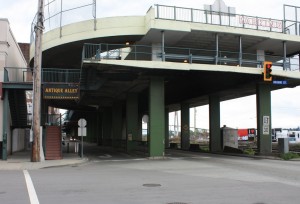
With transit-and pedestrian-oriented development along Columbia, including the MUCF, the Inter Urban, Plaza 88, and with the road diet on Columbia and resultant accessibility of the businesses, there is a resurgence of the Heart of our City. You can’t argue with the business development, with the people on the street, with the positive vibe down there, a sharp contrast to 20 years ago. I can’t shake the feeling that we are approaching a tipping point, though, and the opportunity exists now to build on that momentum, and grow the Heart of the City down to the water, to link it to Quayside and the resurgent River Market, to continue building the Heart of the City up 6th to the new high rise developments (and beyond?), and west to connect to Columbia Square (and beyond with the re-purposing of lower 12th?). Or we can let New Westminster remain a place of unrealized promise, much like it was for the second half of the 20th Century.
The UBE is the beginning of the NFPR process, and I have said before and will say again: no single project is going to have as big an impact on the future of our City than the NFPR. So let TransLink figure out if it is technically or economically feasible to complete (many of us clearly have doubts), but in the meantime, this City has to start discussing whether it is socially feasible.

